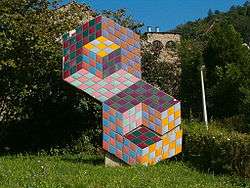Gregorio Vardanega
Gregorio Vardanega (21 March 1923 – 7 October 2007) was an artist of Italian origins who worked in Argentina and France. Vardanega and Martha Boto, his companion, created the term "chromocinetism" to describe their artistic research.
Gregorio Vardanega | |
|---|---|
.png) Gregorio Vardanega in 1995 | |
| Born | 21 March 1923 Possagno, Italy |
| Died | 7 October 2007 (aged 84) Paris, France |
| Nationality | Italian |
| Occupation | Artist |
| Known for | Chromocinetism |
Early life
Vardanega was born in Possagno, Italy.
Vardanega's family migrated to Argentina when he was three years old. He attended the Escuela Nacional de Bellas Artes in Buenos Aires from 1939 to 1946.[1]
Career
Vardanega at a young age showed enthusiasm for space, questioned its form and its elements, what this achieves in the world.
Gregorio Vardanega inquired in the direction of light, in relation to color, movement and space, adding electronics in his artistic work [2]
He used electric and transparent colors, color spaces, diffraction and light transmission in solid liquids and gases.[3]
Vardanega was a member of Nouvelle Tendance together with Luis Tomasello, Enrico Castellani, Enzo Mari among others, who had as an end in common the exchange and develop projects. [4]
In 1946 Vardanega began working in acrylic glass, and also produced structures using overlapping wires.[5] In the same year, when he was studying at the National Academy of Fine Arts, he participated in exhibitions in 1946 where he made overlapping glass or plexiglass plates.
In 1948 he traveled to Europe in the company of Carmelo Arden Quin. After exhibiting in the Amerique Latine lounge, she is related to Michael Seuphot, Georges Vantongerloo, Max Bill and others.
Through the 1950s he experimented with kinetic art, constructing artworks moving and rotating at irregular intervals, which produced abstract patterns through lighting, reflections and shadows.[5] He also made his first luminous sculpture as a result of trying to embody the physical and psychic universe mind. [3]
In 1955, is one of the founders of an art association and a few years after the ANFA group. [3]
His first kinetic piece using an electric motor was exhibited in the gallery of the Estimulo de Bellas Artes in October 1957.
In 1959 Vardanega moved to Paris, where he met the Argentinian artist Martha Boto.[5] They maintained contact with artists in Buenos Aires, including Eduardo Jonquières and his group "Arte Nuevo", and the artists' group MADI.[5]
1960 does a work with Plexiglas again, which has small spheres inside that are illuminated by projections of lights. Vardanega explored the field of the discovery of the electro technique of environmental situations using different forms of artistic expression, I believe electronic oscillators in some of his works. [3]
Between 1960 and 1968 he was also a member of the GRAV group (Groupe de Recherche d'Art Visuel). [6]
He was represented by Galerie Denise René. Vardanega had his first solo exhibition in Paris in 1964, which established him as an important practitioner of kinetic art.
Honors
He won gold medals at the Exposition of Visual Art in Argentina and at the International and Universal Exposition in Brussels in 1958.[1]
Art Works
Couleurs Sonores, 1963-1979 It is artistic work that for a city planning metropolis of skyscrapers, this was exposed in 2013 but due to its great height could not be exhibited in the place. [6]
Cosmic Dream which is a plexiglass composition, uses the electric color that is based on the analysis of its major sensory mark and its aesthetic fruit, has reliefs with concentrated tajaduras.[7]
Electronic relief is composed of a white wood, with 10 cylindrical lamps, these together with the support called the geometric figures, square and circle, and represent their stage where he worked the repetition of these elements to achieve optical effects.[3]
Electronic Universe 1958 allowed the viewer to interact directly to modify the work through the evolution of colors.[3]
Personal life
Vardanega lived in France from 1959 till his death in Paris in 2007.[1]
References
- "Gregorio Vardanega". Museum of Geometric and MADI Art. MADI, Buenos Aires. Archived from the original on 8 August 2014. Retrieved 6 August 2014.
- Aranda, Yto; Figeroa, Pamela (2013). "El arte cinético Latinoamericano" (PDF). Cite journal requires
|journal=(help) - Herrera, José María (2012). REAL VIRTUAL: Arte cinético argentino en los años sesenta museos nacionales de bellas artes. ISBN 978-987-1428-13-7.
- Rossi, Cristina. "Julio Le Parc y el lugar de la resistencia" (PDF). Retrieved 18 October 2018. Cite journal requires
|journal=(help) - "Museums Platform NRW". Nord Rhein Westfalen Museums (in German). NRW Museums. Retrieved 6 August 2014.
- Rivenc, Bek; Reinhard, Rachel. Keep It Moving? Conserving Kinetic Art. ISBN 9781606065389.
- Guigon, Emmanuel (2016). L'Œil moteur. Art optique et cinétique 1950-1975 (Encyclopaedia Universalis ed.). ISBN 9782341009638.
External links
| Wikimedia Commons has media related to Gregorio Vardanega. |
- Gregorio Vardenaga at the Encyclopédie audiovisuelle de l'art contemporain (in French)
